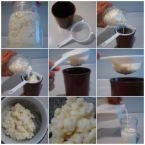
While yogurt can readily be made from the lactic acid bacteria present in fresh yogurt, kefir can only be made from kefir grains and mother cultures prepared from grains. The grains contain a relatively stable and specific balance of microorganisms which exist in a complex symbiotic relationship.
The grains are formed in the process of making kefir and only from pre-existing grains. They resemble small cauliflower florets, and each grain is 3 to 20 mm in diameter (7). Kefir grains are clusters of microorganisms held together by a matrix of polysaccharides. The grains include primarily lactic acid bacteria (lactobacilli, lactococci, leuconostocs) and yeasts, and include acetic acid bacteria and possibly other microorganisms (8).
The overall organization of microorganisms of grains is not completely elucidated. More than a thousand years of consumption have demonstrated that the microorganisms in kefir are not pathogenic. Even further, milk inoculated with grains can suppress the growth of some pathogens such as Salmonella or Shigella (1) . The grain matrix is composed of a complex of 13% protein (by dry weight), 24% polysaccharide, plus cellular debris and unknown components (6) . The principal polysaccharide is a water-soluble substance known as kefiran. Several homofermentative Lactobacillus species including L. kefiranofaciens and L. kefir (9-11) produce this polysaccharide. They are an integral part of the grain, and without their presence, kefir grains cannot be propagated. The mechanism, however, is not fully understood.




No comments:
Post a Comment